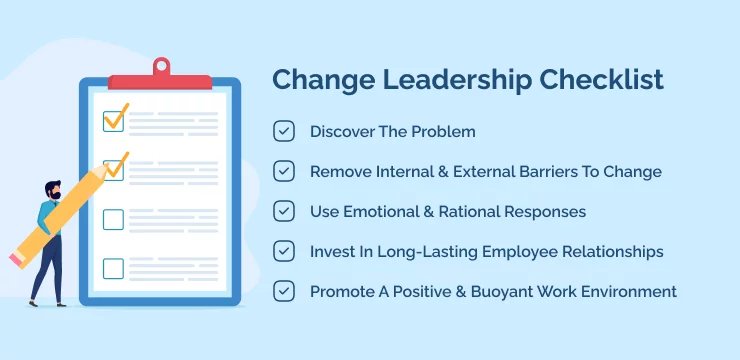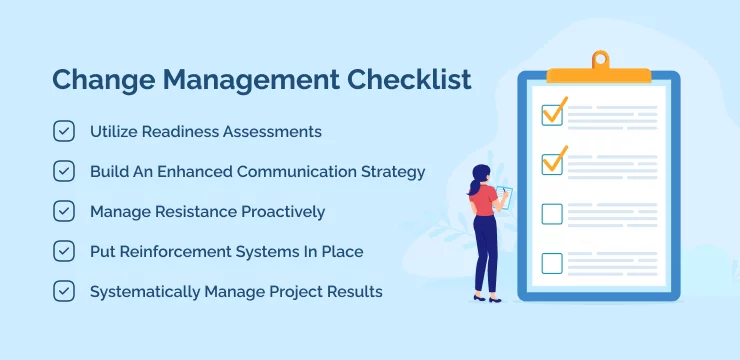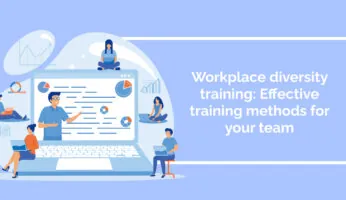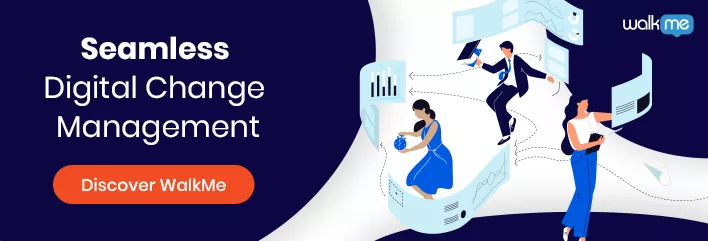
Change management and change leadership are two rising phenomena that have transformed business processes. Their rise to prominence has been essential for helping organizations evolve in constantly shifting digital environments.
Change has a negative perception, and the need to manage change suggests companies must react regularly.
Many interchange change leadership with change management, and though they are interlinked, the concepts are not interchangeable.
Before we get into the crux of change management vs. change leadership, let’s take a look at some outline definitions:
Change Management: The set of essential tools and structures to keep change efforts under control
Change Leadership: The ability to harness the power of people, visions, and processes responsible for large-scale, sustainable transformation.
Change Management Explained
Change management is vital, but change leaders must drive it to be effective. Change management usually concerns small changes (like process improvement) that contribute to a larger picture.
On the other hand, change leadership will direct organizations to new destinations, mobilizing resources that facilitate change. This puts an engine on the whole process, inspiring stakeholders to embrace change.
Change management is more commonly spoken about because it revolves around minimizing mistakes and reducing the barriers that can block the progression of change.
It’s about pushing things along while ensuring things are under control. Usually, change leaders are assigned to oversee the process and ensure it runs in an orderly way.
Change Leadership Explained
Change leadership is an engine. It concerns the people who want to make things happen and is based on the sense of urgency which drives growth.
It’s about big visions and how you can empower your team to realize those visions. There is greater scope for disorderliness, with less control over outcomes.
Everything won’t happen when the leader wants it to, but what’s most important is you have a skilled leader you can rely on.
Though most can manage change, change leadership requires a unique skill set.
It is associated with bigger leaps, greater hazards, and larger bullets. It could be a big challenge in the future, especially since organizational failure has proven nobody is particularly good at it.
Six Change Leadership Steps To Engage & Empower Members Of Your Organization
Urgency
Sometimes it isn’t who strikes the loudest; it’s who strikes first. Though this might defy common logic, there’s always someone who will beat you to the post. It inspires a sense of urgency because technology and competition won’t wait for you.
Once something becomes available, people pounce, meaning it’s vital to be an innovator rather than get left behind. Persistence will help you lead and make changes possible, where it’s best to be one step ahead of the game.
Vision
With a clear vision, you can accelerate the change process. If everyone clearly understands your expectations, they can work in accordance with your goals.
Employees are more likely to embrace change if they understand its reasons and feel they’ve made valuable contributions. That’s why it’s advantageous to involve staff throughout the different stages of change actively.
Coalition
Critical members of staff must unite towards a common goal. With organization-wide sponsorship, your team will be emotionally committed to change.
Your coalition should never fail to neglect the importance of frontline staff, who are often the key drivers of change. Together, you can conquer the challenges change throws your way, but individually these can be difficult to overcome.
Communication
Once you’ve established a vision and united staff, you must master the art of communicating your vision. Create a constant dialogue to clarify important points, and ensure you show your indications to key stakeholders.
A vision for change is one thing, but if staff aren’t aware of your goals, it’s difficult for them to align with your change initiatives.
Poor communication can breed resentment, where staff feels unimportant. And confusion can spread through the organization if you’re vague about your instructions. Communicate early and often to help with the implementation of progressive change.
Quick Wins
To ensure change embeds in the organizational culture, you must celebrate early wins. This will keep staff motivated, with an appreciation they’re heading in the right direction.
Incentivize staff with a rewards-based system to reinforce positive behavior. If staff know they’re doing something right, they’ll feel reassurance to duplicate wins.
Institutionalization
The end goal is to make the change stick. Your change leadership is successful if it becomes part of your organization’s core values.
You can only achieve this if leaders stay on top of the abovementioned efforts, with staff regularly observing the benefits of change.
Leaders should show the staff the connection between their changed behaviors and the organization’s success.
Change Leadership Checklist
Discover The Problem
Mobilize your change team to find the root causes of the obstacles to change and determine how to resolve them. An organizational readiness assessment (in the form of surveys, focus groups, and interviews) should reveal resistance areas.
Remove Internal & External Barriers To Change
Once you’ve identified the change blockers, involve the stakeholders (getting their feedback) to determine the best ways to remove them.
Use Emotional & Rational Responses
Using people’s responses is about getting them to understand the reasons for the change and accept it. Besides the logical side of the change, we need to appeal to the emotional side. So, inspire them with a vision.
What will the future organization look like, what’s better about the new state, and what’s in it for the people? Then gather the people’s feedback throughout the change to address their specific responses to the change management initiative.
Invest In Long-Lasting Employee Relationships
Employees can help each other better than when relying on managers for training. So establish mentor-mentee relationships between employees who’ve adopted the change and those struggling. And set up formal peer-to-peer learning programs like pairing employees for one-to-one sessions.
Promote A Positive & Buoyant Work Environment
Rewarding good performance is the best way to promote a positive environment when leading a change effort. Set up reward systems for adopting and advancing change initiatives. Besides bonuses, recognition and awards also motivate employees to further the change.
Change Management Checklist
Utilize Readiness Assessments
A readiness assessment helps uncover resistance areas, which guide resistance management activities. Is the organization ready to initiate, implement and maintain the changes?
A readiness assessment considers the enterprise, employees, company culture, sponsors, and other key stakeholders to determine:
- their awareness of the change
- whether they support the change
- their proficiency and knowledge of the new system/tools
- the organization’s capacity to change
Build An Enhanced Communication Strategy
Clear and effective communication helps people understand the reasons for the change and what the changes involve. Why change, and what’s the risk of not changing? When it’s two-way, leaders can learn about arising concerns and address them as they implement the change.
A change management communication strategy includes the talking points for each stakeholder, when they’ll receive the message, and their preferred communication channel.
Manage Resistance Proactively
It’s hardly about whether there’ll be resistance. Instead, it’s about how much resistance and where’s the opposition coming from? As we previously mentioned, readiness assessments help to identify resistance areas. And to manage resistance proactively, especially for large-scale changes, organizations create a resistance management plan early on in the project. It outlines how to identify resistance and manage it in all departments.
Put Reinforcement Systems In Place
Reinforcement in change management is primarily about recognizing good performance and successful adoption to sustain the change. So a reinforcement system includes financial (bonuses) and nonfinancial incentives (awards, career development opportunities, etc.) for successfully adopting the change or achieving the change management KPIs. Since most transformations last months, define short-term milestones so employees can celebrate small wins.
Systematically Manage Project Results
Establish organizational change management KPIs to track progress and improve constantly. The KPIs measure change activities, communication and training effectiveness, and other vital aspects of the change against the project baseline (schedule, scope, and cost).
The specific tools for evaluating change management progress are employee satisfaction surveys, change management surveys, overall project KPI measurements, system usage reports, cost/risk/benefits analysis, process maps, and flowcharts.
Metrics for measuring change:
- the amount of time people take to adopt a change
- how many people adopt the change
- satisfaction with training and communication efforts
- frustration/comfort levels when using the new system
- employees’ success rate after executing the change
The Best Change Leadership Models
The best change leadership models are ADKAR, Kotter, and Barach approaches.
ADKAR Approach
Jeff Hiatt’s ADKAR approach focuses on change at the individual level because an organization can only change if individuals change. It outlines the goals of a successful change and its outcomes, which allows change leaders to focus on the activities that will achieve the desired results.
The ADKAR approach involves answering key questions to determine what you need to drive the change. It also helps to determine when, why, and how to use change leadership tools.
ADKAR is an acronym for Awareness, Desire, Knowledge, Ability, and Reinforcement, which represents stages in leading change.
Awareness (of the need for change)
- What’s the change?
- Why does the organization need to change?
- What’s the risk of not implementing the change?
Desire (to change)
- What’s the personal motivation that’ll support the change?
- What are the organizational drivers that’ll support change?
Knowledge (About the change)
- How do we change?
- What knowledge and skills do we need to change successfully?
Ability (to change)
- What are the barriers to the change? Resistance, incompetence, etc.
Reinforcement (to make the change stick)
- What form of recognition, incentives, and rewards will reinforce the change?
- What other mechanisms will sustain the change? e.g., gathering employee feedback periodically
Bacharach Approach
Organizational behavior professor, Samuel Bacharach, developed the Bacharach approach that views leaders as agents of change. According to Bacharach, “Leadership is a narrative of execution.” So he sums up a change leader’s job into three things: working with your people to generate ideas, mobilizing them to move the ideas forward, and maintaining momentum.
The Bacharach Approach outlines guiding principles for managing change:
- Establish the change’s agenda
- Map out the political terrain in your organization
- Get the people on your side in an organic way
- Make the changes happen
Bacarach reaffirms that leaders need “the political skills to mobilize others around good ideas and the managerial skills to sustain momentum to put the ideas in place,” And change is best sustained through political agility, culture, and vision. He outlines the sources of momentum that leaders should focus on to support the change as:
- Structural – maintain the organization’s capacity and keep things rolling
- Performance – monitor the change and make necessary adjustments
- Cultural – motivate your people to sustain focus on the change
- Political – mobilize the people’s support and anticipate opposition
Kotter Method
John Kotter observed many organizations and leaders come up with these eight steps for leading change:
- Establish a sense of urgency – help the people see the need for change and why they should act immediately.
- Build a guiding coalition – put together a competent team to guide and communicate the change’s activities.
- Develop the change’s strategic vision and clarify the initiatives – how will the future look, and how do we get there?
- Enlist your volunteer army – people willing to implement the change urgently.
- Remove barriers to enable action – hierarchies, inefficient processes, etc.
- Recognize and communicate small wins to motivate volunteers and track progress.
- Sustain acceleration – stay relentless after the first success to initiate change after change until you reach the vision.
- Institute the change – help people see the connection between the new behaviors and corresponding organizational successes.
The Best Change Management Models
The top change management models for technology-driven organizations are Lewin’s model, McKinsey’s 7s framework, and Kotter’s 8-step model.
Lewin’s Change Model
Kurt Lewin’s change management model is a simple 3-step framework for making a change successful. He compares his process to how ice changes shapes in three simple steps: unfreeze (prepare to transition), change, and refreeze (reinforce the new behaviors to make them stick).
Step 1: Freeze (Prepare for change)
This stage is about getting the organization ready to change from its current state. It involves four key steps:
- Establish and clarify the need for change
- Gather support from key stakeholders
- Develop a communication strategy on the need for change
- Appreciate apprehensions and manage them
Step 2: Change
Once the organization unfreezes from the old ways, the people are ready to transition to the future state. This is the implementation stage. The key steps include:
- Having clear, consistent communication
- Involving the people in the change process
- Senior leaders hold sessions to answer the people’s questions
- Leaders becoming role models for the desired changes
Step 3: Refreeze (reinforce the changes)
This last step is about sustaining the new culture. Leaders aim to ensure that the people adopt the changes and become comfortable with them. The key steps in this stage are:
- Planning to sustain the change
- Supporting the people
- Celebrating and communicating success
The McKinsey 7-S Model
McKinsey’s 7-S framework addresses seven elements in change that influence an organization’s ability to change. Organizations use McKinsey’s model to coordinate the seven interrelated factors. They all work together, so leaders need to address each in tandem. The framework also guides leaders to align processes and examine the effects of the changes.
The seven elements are:
- Skills – individual and institutional skills
- System – systems and processes
- Structure – authority/reporting relationships
- Staff – how to grow and develop the people
- Strategy – the organization’s competitive advantage
- Style (or culture) – how people do things in the organization
- Shared values– what’s the organization trying to achieve?
To use the framework, start by ensuring that the organization’s Shared values are consistent with the Strategy, Systems, and Structure. Then ensure that Strategy, Systems, and Structure support each other – assess and determine what you need to change. And finally, ensure that Skills, Style, Staff, and Shared values support each other and the Strategy, Structure, and Systems. It’s an iterative process.
Kotter’s Change Management Theory
As previously mentioned, Kotter’s model has eight steps. The following steps for managing change are based on the reasons why change initiatives fail:
- Step 1: Create an urgency to change
- Step 2: Create a guiding coalition – people with the authority and skills to champion the change
- Step 3: Establish the change’s vision and strategy
- Step 4: Communicate the vision
- Step 5: Remove obstacles to empower action
- Step 6: Celebrate wins
- Step 7: Inspire more change
- Step 8: Anchor the change in the culture
Change Leadership Core Concepts
The core concepts in change leadership are leading with culture (enforcing the current culture elements that align with the change), starting with committed and aligned execs who support the change leader, and involving mid-level managers and frontline people in designing the change.
Change Management Core Concepts:
- Appeal to both the rational and emotional sides of the people
- Senior leaders should be role models for the desired changes
- Involve stakeholders at all levels
- Involve informal leaders as guides and participants
- Establish formal change management systems – training, rewards, etc.
- Assess progress and adapt
Successful change management involves understanding and communicating the change, planning, and implementing your strategic objectives. The core concepts in this process are conducting a stakeholder analysis, having a communication strategy, addressing the company culture, and managing resistance through digitization.
Change Leadership vs. Change Management: Final thoughts
Both change management and change leadership are useful in project management. But the change leadership approach is primarily applied in large-scale changes.
It is about the vision, strategy, and driving forces that fuel comprehensive transformations. In contrast, change management refers to the activities for implementing a change while minimizing disruptions and managing resistance.
WalkMe Team
WalkMe spearheaded the Digital Adoption Platform (DAP) for associations to use the maximum capacity of their advanced resources. Utilizing man-made consciousness, AI, and context-oriented direction, WalkMe adds a powerful UI layer to raise the computerized proficiency, everything being equal.





